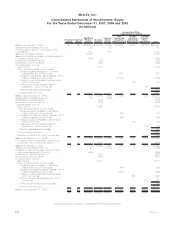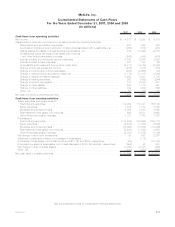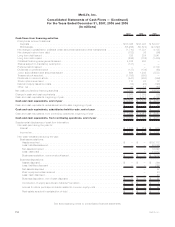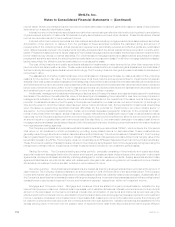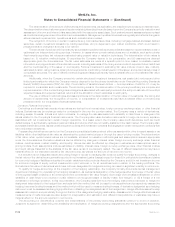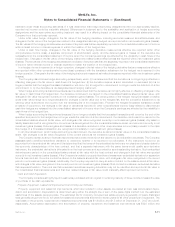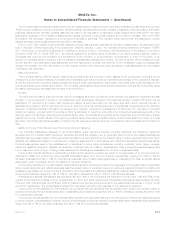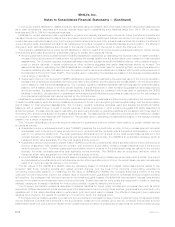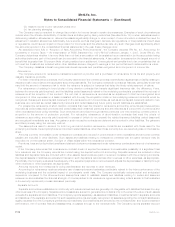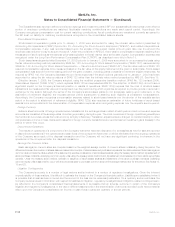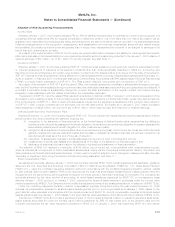MetLife 2007 Annual Report Download - page 105
Download and view the complete annual report
Please find page 105 of the 2007 MetLife annual report below. You can navigate through the pages in the report by either clicking on the pages listed below, or by using the keyword search tool below to find specific information within the annual report.interest rate, the value of the loan’s collateral if the loan is in the process of foreclosure or otherwise collateral dependent, or the loan’s
market value if the loan is being sold. The Company also establishes allowances for loan losses when a loss contingency exists for
pools of loans with similar characteristics, such as mortgage loans based on similar property types or loan to value risk factors. A loss
contingency exists when the likelihood that a future event will occur is probable based on past events. Interest income earned on
impaired loans is accrued on the principal amount of the loan based on the loan’s contractual interest rate. However, interest ceases
to be accrued for loans on which interest is generally more than 60 days past due and/or where the collection of interest is not
considered probable. Cash receipts on such impaired loans are recorded as a reduction of the recorded investment. Gains and
losses from the sale of loans and changes in valuation allowances are reported in net investment gains (losses).
Policy Loans. Policy loans are stated at unpaid principal balances. Interest income on such loans is recorded as earned using
the contractually agreed upon interest rate. Generally, interest is capitalized on the policy’s anniversary date.
Real Estate. Real estate held-for-investment, including related improvements, is stated at cost less accumulated depreciation.
Depreciation is provided on a straight-line basis over the estimated useful life of the asset (typically 20 to 55 years). Rental income is
recognized on a straight-line basis over the term of the respective leases. The Company classifies a property as held-for-sale if it
commits to a plan to sell a property within one year and actively markets the property in its current condition for a price that is
reasonable in comparison to its fair value. The Company classifies the results of operations and the gain or loss on sale of a property
that either has been disposed of or classified as held-for-sale as discontinued operations, if the ongoing operations of the property will
be eliminated from the ongoing operations of the Company and if the Company will not have any significant continuing involvement in
the operations of the property after the sale. Real estate held-for-sale is stated at the lower of depreciated cost or fair value less
expected disposition costs. Real estate is not depreciated while it is classified as held-for-sale. The Company periodically reviews its
properties held-for-investment for impairment and tests properties for recoverability whenever events or changes in circumstances
indicate the carrying amount of the asset may not be recoverable and the carrying value of the property exceeds its fair value.
Properties whose carrying values are greater than their undiscountedcashflowsarewrittendowntotheirfairvalue,withthe
impairment loss included in net investment gains (losses). Impairment losses are based upon the estimated fair value of real estate,
which is generally computed using the present value of expected future cash flows from the real estate discounted at a rate
commensurate with the underlying risks. Real estate acquired upon foreclosure of commercial and agricultural mortgage loans is
recorded at the lower of estimated fair value or the carrying value of the mortgage loan at the date of foreclosure.
Real Estate Joint Ventures and Other Limited Partnership Interests. The Company uses the equity method of accounting for
investments in real estate joint ventures and other limited partnership interests in which it has more than a minor equity interest or more
than a minor influence over the joint ventures or partnership’s operations, but does not have a controlling interest and is not the
primary beneficiary. The Company uses the cost method of accounting for investments in real estate joint ventures and other limited
partnership interests in which it has a minor equity investment and virtually no influence over the joint ventures or the partnership’s
operations. In addition to the investees performing regular evaluations for the impairment of underlying investments, the Company
routinely evaluates its investments in real estate joint ventures and other limited partnerships for impairments. For its cost method
investments, the Company follows an impairment analysis which is similar to the process followed for its fixed maturity and equity
securities as described previously. For equity method investees, the Company considers financial and other information provided by
the investee, other known information and inherent risks in the underlying investments, as well as future capital commitments, in
determining whether an impairment has occurred. When an other-than-temporary impairment is deemed to have occurred, the
Company records a realized capital loss within net investment gains (losses) to record the investment at its fair value.
Short-term Investments. Short-term investments include investments with remaining maturities of one year or less, but greater
thanthreemonths,atthetimeofacquisitionandarestated at amortized cost, which approximates fair value.
Other Invested Assets. Other invested assets consist principally of leveraged leases and funds withheld at interest. Leveraged
leases are recorded net of non-recourse debt. The Company participates in lease transactions which are diversified by industry, asset
type and geographic area. The Company recognizes income on the leveraged leases by applying the leveraged lease’s estimated rate
of return to the net investment in the lease. The Company regularly reviews residual values and impairs them to expected values as
needed.
Funds withheld represent amounts contractually withheld by ceding companies in accordance with reinsurance agreements.
For agreements written on a modified coinsurance basis and certain agreements written on a coinsurance basis, assets supporting
the reinsured policies, and equal to the net statutory reserves, are withheld and continue to be legally owned by the ceding
companies. The Company records a funds withheld receivable rather than the underlying investments. The Company recognizes
interest on funds withheld at rates defined by the treaty terms which may be contractually specified or directly related to the
investment portfolio and records it in net investment income.
Other invested assets also include stand-alone derivatives with positive fair values and the fair value of embedded derivatives
related to funds withheld and modified coinsurance contracts.
Estimates and Uncertainties. The Company’s investments are exposed to three primary sources of risk: credit, interest rate
and market valuation. The financial statement risks, stemming from such investment risks, are those associated with the recognition
of impairments, the recognition of income on certain investments, and the determination of fair values.
F-9MetLife, Inc.
MetLife, Inc.
Notes to Consolidated Financial Statements — (Continued)







